#foley square protest
Text
I've always cared deeply about reproductive health and I will always continue to fight for birth control and abortion access. However, I fail to understand why the Pro-Palestinian movement has gotten so involved in the American Pro-Choice movement.
Tomorrow, there's an NYC Loves Abortion rally in Foley Square. One of the organizations participating is NYC Healthcare Workers for Palestine - the same organization that protested the Memorial Sloan Kettering Cancer Center back in January.
Hamas raped people on October 7th. Several survivors have spoken about their trauma. It's highly likely that some of the remaining hostages being held in Gaza are several months pregnant or dead. Surely that would be more relevant to the importance of abortion access, the trauma of sexual violence, and bodily autonomy?
#I'm truly in disbelief#Will the survivors of October 7th massacre even be mentioned at all?#Some days it all feels so hopeless.
62 notes
·
View notes
Text
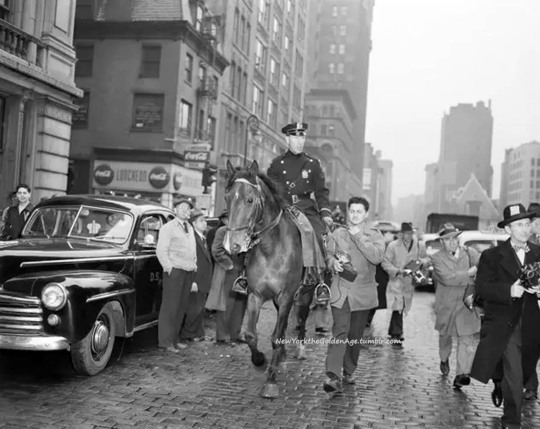
A mounted policeman uses demonstrator's necktie as a leash as he leads him away from Foley Square, April 28, 1950. The area, near City Hall, was the scene of a riotous demonstration for the fourth consecutive day as throngs of high school students protested curtailed school activities and teachers' pay scales. Mounted police and officers on foot routed the fist-shaking teenagers.
Photo: Associated Press via the Fayetteville Observer
#vintage New York#1950s#demonstration#protest#mounted police#riot#students#student demonstration#high school students
57 notes
·
View notes
Text

Abortion rights protest in Foley Square - New York City, May 2nd
22 notes
·
View notes
Text

A leaked draft memo from Samuel Alito on May 2 indicates the intention of the fascist majority on the Supreme Court to overturn Roe v. Wade.
This is an ATROCITY, but it is not yet law and doesn’t have to become law. It is what they are on track to do IF WE DO NOT STOP THEM.
NOW IS THE TIME TO TAKE TO THE STREETS and RISE UP 4 ABORTION RIGHTS!
Join emergency protests everywhere you can find them, including:
NYC: 5:00 pm Foley Square
LA: 12:00 on at US Courthouse, 1st & Hill, downtown LA
There is a call to protest tonight at courthouses, city halls, and town squares everywhere Tuesday 5:00 pm local time.
#abortionban #abortionrights #green4abortion #riseup4abortionrights #supremecourt
Via Rise Up For Abortion Rights
12 notes
·
View notes
Text
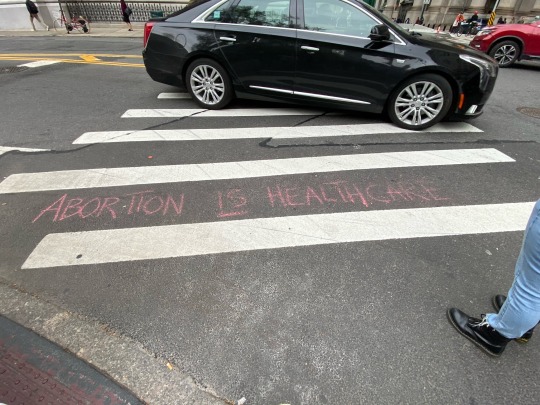
walking to the foley square protest, 5/3/22
5 notes
·
View notes
Video
PROTESTS609 by a Psychiatrist's view
Via Flickr:
Abortion Surges to the Center of the 2024 Campaign... Democrats are vowing to make abortion rights a pillar of their campaigns, while Republicans are caught between their conservative base and a public that generally backs access to the procedure. Roe. vs. Wade a Protest Foley Square in ManHatTan Photography’s new conscience linktr.ee/GlennLosack
#abortion#rights#woman's#pro#choice#supreme#court#protests#manhattan#nyc#foleysquare#murder#fetus#embryo#glennlosack#utero#god#jesus#photojournalism#streetphotographer#streetphotography#flickr
0 notes
Text
The Biden administration will declare monkeypox a public well being emergency
The Biden administration will declare monkeypox a public well being emergency
People protest throughout a rally calling for extra authorities motion to fight the unfold of monkeypox in Foley Square on July 21, 2022 in New York City.
jeenah moon | Getty Images
The Biden administration is declaring monkeypox a public well being emergency because the U.S. outbreak has grown into the most important on this planet, the nation’s high well being official mentioned…

View On WordPress
0 notes
Text
May 3, 2022
9:00 p.m. I noticed a protest at Foley Square after work and realized it was in response to the leaked SCOTUS ruling on abortion (Roe v. Wade).
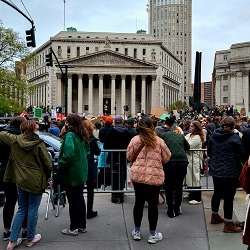
0 notes
Text
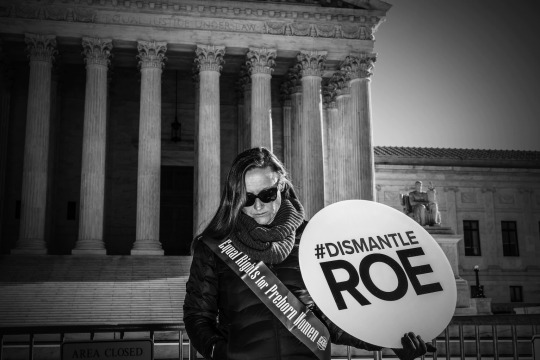
An anti-abortion supporter takes part in a rally at the U.S. Supreme Court on January 22, 2022—the 49th anniversary of Roe v. Wade. The 1973 ruling that women had a constitutionally protected right to terminate a pregnancy has been contested since it was handed down.
The Tumultuous History That Led To The Landmark Roe v. Wade Ruling
In the 1960s, support for abortion mounted as two public health crises caused miscarriages and severe health problems among newborn children—setting the stage for the historic U.S. Supreme Court case.
— June 23, 2022 | By Erin Blakemore | Photographs By Mark Peterson, Redux | History & Culture Explainer
In April 1970, Jane Hodgson picked up the phone, called her local police department, and asked them to arrest her.
Earlier that day, the Minnesota physician had performed an abortion on a 24-year-old mother of three who had contracted rubella, a disease associated with miscarriage, infant death, and severe health problems for infants that survived pregnancy. As in many other states, Minnesota law only allowed “therapeutic abortions,” procedures that terminated pregnancy only if a mother’s life was threatened.
Hodgson had seen patients beg for illegal abortions��and suffer, even die, when they obtained them from other, unqualified providers. In an affidavit to the grand jury that indicted her, she wrote that she “had to make a choice between following the existing law or fulfilling her obligation to her patient, her profession, and her society.”
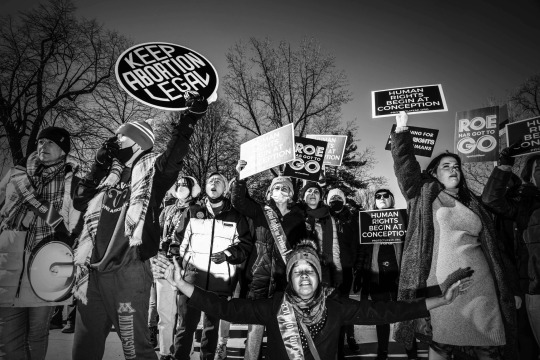
Pro-choice and anti-abortion supporters gather for competing rallies at the U.S. Supreme Court on January 22, 2022.
In anticipation of a Supreme Court decision expected to shatter decades of precedent upholding the right to terminate a pregnancy, here’s a look at the period that led up to the landmark decisions, what those two cases involved, and their legacy.
Reconsidering The Nation’s Abortion Bans
Though abortion was not particularly controversial in the nation’s early years, opposition grew in the late 19th century and the procedure became increasingly taboo. By the mid-20th century, it was also illegal. Though women regularly sought—and got—abortions, they were a felony in nearly every state by the late 1960s, and these laws offered few, and sometimes no, exceptions related to the mother’s health or cases of incest and rape.
During that decade, though, two public health crises brought debate about abortion into the open. The first was thalidomide, a drug marketed in Europe as a remedy for morning sickness, anxiety, and sleeplessness. About 10,000 babies born worldwide to mothers who had taken thalidomide had severe physical anomalies, and thousands of women experienced miscarriages due to the drug, leading manufacturers to withdraw it.
Though the drug was never legal in the U.S., Sherri Finkbine, an American actress known for her role as “Miss Sherri” on Romper Room, a show for kids, inadvertently took it early in her pregnancy. After learning she had taken the drug, she gave a newspaper interview in hopes of publicizing its dangers. She had asked for anonymity, but after the story broke, her hospital refused to provide an abortion—and neither would any other facility.

Left: Later that month, thousands of people took part in the Bans Off Our Bodies abortion rights rally in New York City, marching across the Brooklyn Bridge to Foley Square in Manhattan on May 14, 2022. Right: Top: Members of St. Patrick’s Old Cathedral lead a group of protesters to the Planned Parenthood clinic in New York City on February 5, 2022. They were met by a group called NYC For Abortion Rights.
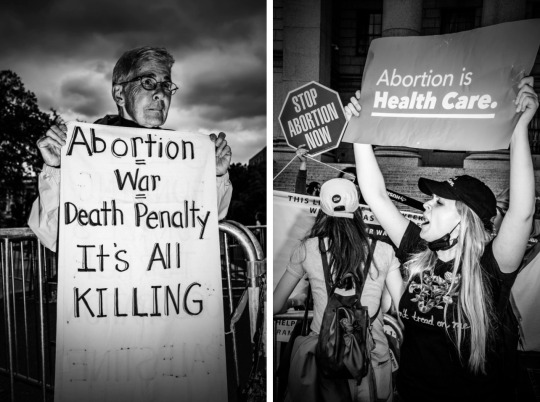
Left: A counter-protester holds up a sign at a pro-choice rally held in Washington, D.C., on May 5, 2022—just days after the leak of a draft majority opinion suggested that the Supreme Court was poised to strike down Roe v. Wade. Right: Pro-choice and anti-abortion activists both rally at the May 14 Bans Off Our Bodies march in New York City.
It would take a trip to Sweden to finally get the abortion. Although she weathered public condemnation and death threats, and was fired from her job, a majority of Americans supported Finkbine’s decision, according to a 1962 Gallup poll.
Support for abortion mounted in the mid-1960s with an epidemic of the rubella virus, also known as German measles. Pregnant women who had contracted rubella began experiencing miscarriages. Many newborn babies died; an estimated 20,000 were born with congenital abnormalities like deafness, atypical anatomy, intellectual disabilities, and heart problems. Though many doctors, like Hodgson, supported abortions for pregnant women who had contracted rubella, laws outlawing abortion in most cases put them in danger of arrest, loss of licensure and other penalties.
As debates about abortion raged, two test cases that would transform U.S. abortion law were making their way through the U.S. court system.

People pray outside a Planned Parenthood clinic in New York City on February 5, 2022. St. Patrick’s Old Cathedral is led by Fidelis Moscinski, a Franciscan priest who has been arrested for blocking clinics around the country.
Jane Roe and The Constitutional Right To Privacy
In 1969, 21-year-old Norma McCorvey became pregnant. It was her third pregnancy; because of struggles with money and substance abuse, she did not parent either child. This time, she wanted an abortion. But though some states had begun to slightly liberalize their abortion laws, McCorvey lived in Texas, which banned abortions unless the mother’s life was at stake.
Unlike wealthier and better resourced women, McCorvey could not afford to leave the state or obtain a hush-hush abortion from a reliable physician. But she had heard about a pair of attorneys looking to file a test case with a potential plaintiff like her—someone whose age and social class would illustrate the unfairness of abortion laws.

During their protest at the Planned Parenthood clinic, members of the St. Patrick’s Old Cathedral group brought crosses, rosaries, and other religious artifacts to underscore their opposition to abortion.
McCorvey agreed to participate in a lawsuit filed by attorneys Sarah Weddington and Linda Coffee. The case was filed with the pseudonym Jane Roe, a term commonly used in lawsuits when a woman wishes to conceal her identity. Her legal team sued Henry Wade, district attorney of the county in which “Jane Roe” lived, arguing that Texas’ law violated women’s constitutional right to privacy—their freedom to live without undue governmental intrusion in their personal lives.
A three-judge U.S. District Court panel agreed, ruling the Texas law unconstitutional. But the court declined to order Texas to stop enforcing the old law, and Wade refused to stop prosecuting doctors. As McCorvey’s case made its way through the court system, she ultimately gave birth for a third time and placed the child for adoption.
Mary Doe Expands The Argument
Meanwhile, Doe v. Bolton, another test case, wended its way through the courts. When 22-year-old Georgia resident Sandra Bensing got pregnant with her fourth child in 1970, she decided she wanted an abortion. Though married, she was pursuing a divorce and had trouble trying to raise her children, each of whom had been adopted or were in foster care.
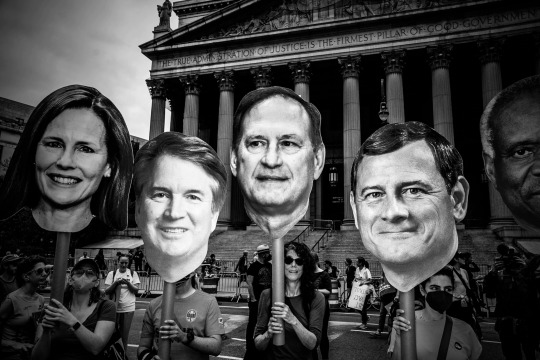
Protesters at the Bans Off Our Bodies rally in New York City hold up signs depicting the conservative members of the U.S. Supreme Court.
At the time, Georgia forbade abortion except in cases of danger to the mother’s life or the possibility of a disabling injury; cases of rape; or cases in which a fetus was likely to be born with a severe anatomical anomaly or mental disability. Each potential caveat was accompanied by an almost insurmountable burden of proof: A woman who had been raped had to document it, for example, and family or friends could go to court to bar her from getting the procedure.
When a hospital refused to provide Bensing a therapeutic abortion, attorneys from the Legal Aid Society and the American Civil Liberties Union recruited her for a test case and sued Georgia attorney general Arthur Bolton. The lawyers argued that not only should “Mary Doe” have been approved for the abortion because of a psychiatric disability, but that the law infringed on her constitutional right to privacy and self-determination and prevented medical professionals from doing their jobs.
Bensing eventually got an abortion at a private hospital that was not subject to the same laws as the public hospital, but the lawsuit went forward anyway. In 1970 a three-judge District Court panel found that women had a right to pursue abortions even if they had not been raped, weren’t in danger of death, and were not carrying a fetus that was at risk of severe health concerns. The panel also ruled that restrictions on abortions within the first trimester violated women’s privacy rights—but added that states had a valid interest in overseeing abortion as part of their duty to protect life, which included fetuses.
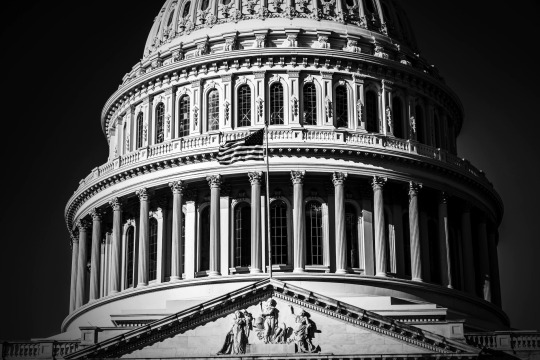
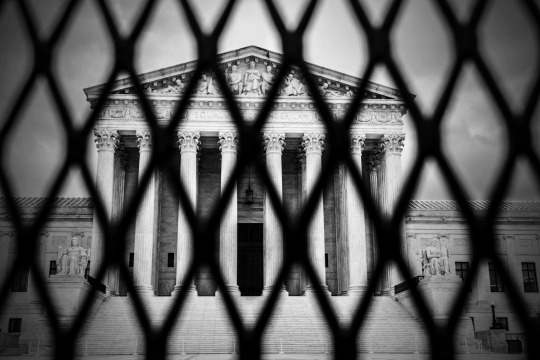
In the years since Roe v. Wade was handed down, the U.S. Capitol Building and U.S. Supreme Court have regularly be the site of rallies from protesters on both sides of the issue.
Roe and Doe At The Supreme Court
In 1973, both cases—and the future of abortion access in the U.S.—were in the hands of the U.S. Supreme Court.
Weddington argued Roe v. Wade before the U.S. Supreme Court in 1971 and 1972. She was just 26 years old at the time of the initial oral argument; the case was the first she had ever taken to trial. As she stood before the all-male justices, she argued that abortions were an individual decision and that when states like Texas forbade them, the courts were women’s only recourse.
Calling abortion “an important decision” in women’s personal lives, she pointed out the danger of pregnancy and childbirth. “A pregnancy to a woman is perhaps one of the most determinative aspects of her life,” said Weddington in her arguments. “It disrupts her body. It disrupts her education. It disrupts her employment. And it often disrupts her entire family life.”
The Supreme Court decided Roe v. Wade and Doe v. Bolton on the same day. On January 22, 1973, it found in Roe that a woman’s decision to terminate her pregnancy falls under her constitutional right to privacy. It also ruled that states have an interest in protecting both pregnant women and “the potentiality of human life”—allowing states to regulate abortion after the first trimester of pregnancy and enact requirements about things like the professional qualifications of people performing abortions. During the third trimester, states could prohibit the procedures as long as their laws contained exceptions for the mother’s life or ongoing health.

A youth activist group called Gen Z for Change rallies for abortion rights in front of the Supreme Court on May 5, 2022. Members of Gen Z have never known life without the constitutionally protected right to an abortion.
In Doe, the court reiterated that “a woman’s constitutional right to an abortion is not absolute”—but that it was unduly restrictive to require more than one medical practitioner or entire hospital committees to weigh in on an abortion’s necessity. The court also found that states could not at any point in pregnancy prohibit abortions deemed necessary to protect women’s health—which could include “all factors physical, emotional, psychological, familial, and the women’s age relevant to the well-being of the patient.”
Response To The Rulings
In one fell swoop, the Supreme Court had swept aside a century of abortion restrictions and rendered 46 states’ laws unconstitutional. But initial response to the landmark decision was subdued and overshadowed by other political issues. Many Protestant leaders either did not publicly object to the ruling or expressed outright approval. But Catholic bishops protested immediately, and regional anti-abortion groups—which had been fighting liberalization laws in their own states—coalesced within weeks into a national movement determined to see the decisions reversed.
Meanwhile, American women responded in droves. Before Roe and Doe, estimates suggested there were about 130,000 illegal abortions each year in the United States; afterward, as Center for Disease Control statisticians documented, that number dropped to 17,000 in 1975. The number of women formally determined to have died due to an illegal abortion dropped from 39 in 1972 to three in 1975, and they wrote that “with the continued increase in legal abortion services, illegal abortion may soon be virtually eliminated as a cause of death.”
By 1980, nearly 1.6 million abortions were performed per year in the U.S. Over time, the procedure became safer, more accessible, and less expensive, and was offered in freestanding clinics on an outpatient basis instead of just hospitals.
As for Hodgson, the doctor who defied Minnesota law, she never ended up serving jail time, and her conviction was overturned in the wake of Roe and Doe. Despite harassment for her public stance, she spent the rest of her career performing abortions—and fighting to improve women’s reproductive health.
0 notes
Photo
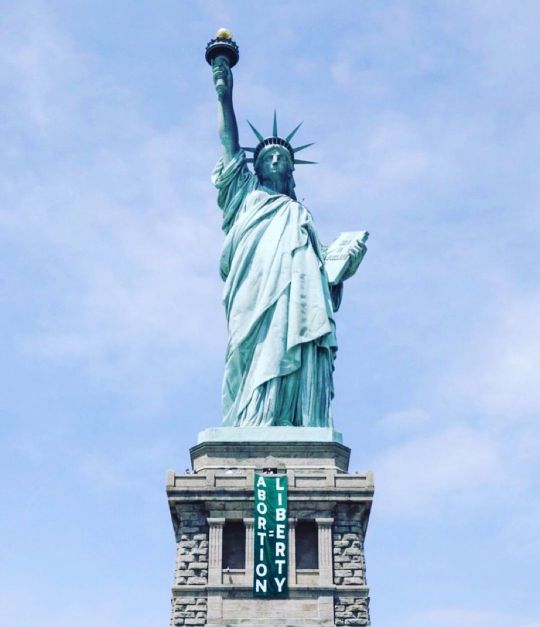
Lots of walks, events and protests going on around the country today. If you can get to Foley Square, show up! #abortionrights #abortionishealthcare #bansoffourbodies #nyc #newyork https://www.instagram.com/p/Cdi_gVrOf_H/?igshid=NGJjMDIxMWI=
0 notes
Text
Democratic Leaders Are Getting the Abortion Story Wrong — Again
Democratic Leaders Are Getting the Abortion Story Wrong — Again
With Roe at death’s door, will the party finally change its tune?
Protesters in New York City’s Foley Square demonstrate against a Supreme Court draft opinion striking down Roe v. Wade. Photo: Sabrina Santiago
The news of Samuel Alito’s draft majority opinion overturning Roe v. Wade on Monday didn’t just break — it shattered. It was the unexpected timing, yes. And the unprecedented nature of…
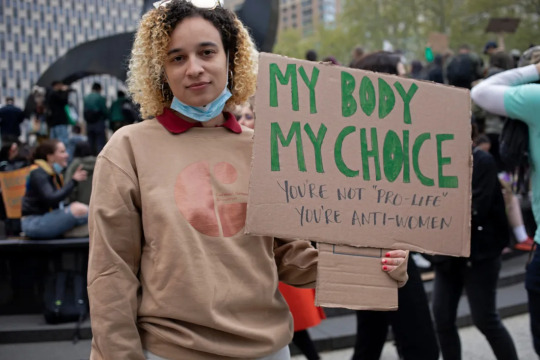
View On WordPress
0 notes
Text
Foley Square Abortion-Rights Rally in New York
Foley Square Abortion-Rights Rally in New York
Although the thousands of protesters who showed up at Foley Square on Tuesday evening had presumably spent much of the day doom-scrolling, the mood was oddly jubilant. At 5 pm, demonstrators in abortion-rights green trickled into the square to protest the leaked Supreme Court draft opinion that revealed the justices have privately voted to overturn roe v. wade.
It’s an outcome…

View On WordPress
0 notes
Text
2.5 hours to get 93% back. Maybe just a little less. It’s depends what I’m doing. I have the news on and it’s interesting to know exactly where they are when they say street names and where they are shot by shot. Foley square is where I’ve been for protests. The most recent was abortion.
2 notes
·
View notes
Text
Violent Protests Erupt in Los Angeles
LOS ANGLES (OnlineColumnist.com), May 4, 2022.--Violent protests erupted in downtown Los Angeles today, all over the leaked draft opinion of Associate Supreme Court Justice Samuel Alito declaring the end of 1973 Roe v. Wade, the landmark ruling legalizing abortion in the United States. Protesters tossed bottles and rocks at the police, trying to maintain order over protests over the prospects of the Supreme Court ruling to end Roe v. Wade. No one knows for sure whether Alito’s leaked draft opinion reflects the views of four other conservative justices or just Alito’s views against Roe v. Wade. About 250 demonstrators marched from the federal courthouse in Downtown Los Angeles to Pershing Square, a walk of maybe four blocks. Videos posted on Facebook shows Los Angeles Police Department officers tackling protesters near a fire hydrant, while other protester were struck with police truncheons for crowd control
Chief Justice John Roberts, 67, was stunned when liberal news site Politico published Alito’s draft opinion citing the end of Roe v. Wade. Roberts ordered the High Court’s Marshal to investigate the leak, knowing that one of its staff, either long-term employee or a law clerk, stabbed the High Court in the back. Roberts said the Supreme Court, one of the three independent branches of government, required confidentiality to properly review cases for significant Constitutional rulings. With a mole embedded in the court, Roberts understands that it’s difficult for the High Court to do its job with interference. Demonstrations around the country, some on the steps of the Supreme Court, show an angry mob protesting an expected Supreme Court decision, essentially warning the court that there would be consequences, possibly violence, for a ruling running against prevailing public opinion.
Watching protesters toss bottles and rocks at the LAPD shows the kind of unlawful protesting to often sweep Americans streets since the May 25, 2020 death of George Floyd. For almost six months following Floyd’s deaths, protesters around the country routine burned, looted and trashed American cities. Today’s anti-Supreme Court protesters, advocating protection of Roe v. Wade, mixed it up with the police, all because they could get away with it. Protesters surrounded LAPD officers and Homeland Security personnel trying to maintain law-and-order on the streets. Law enforcement isn’t responsible for any Supreme Court ruling, whether it pleases or infuriates demonstrators. Whatever the merits of the Roe v. Wade controversy, demonstrators know the police only enforce law-and-order, don’t take a position on the expected ruling giving rise to violent protests.
Violent street protests have been a fashionable trend of anarchists infiltrating otherwise peaceful demonstrations, something unknowing to activists and protesters trying to advance their cause. Anarchists take advantage of crowds massing to express grievances, in this case about an expected ruling by the Supreme Court on Roe v. Wade. Roberts said the Supreme Court would not allow the angry mob to affect its rulings, whether the rulings have popular support of not. It’s obvious that sizable numbers of women and men support a women’s right to choose abortion guaranteed by Roe v. Wade. However large national groups of pro-life advocates, they’ve made a determined effort since the 1973 Roe v. Wade to overturn the Supreme Court ruling. Alito’s draft opinion gives them reason for hope. Street demonstrators have an obligation to follow laws related to peace street protests.
Tossing rocks and bottles at the police for maintaining law-and-order weakens the cause of demonstrators hoping to influence the Supreme Court vote. But as Roberts said, the Supreme Court, to effectively do its Constitutional job, must be free from the angry mob that would coerce decision based on passion and public sentiment. Demonstrating in Lower Manhattan’s Foley Square, New York Atty. Gen. Letitia James joined the protests, saying over 20 years ago she “walked into Planned Parenthood.” James was responsible for compiling information about sexual harassment that eventually forced former Gov. Andrew Cuomo out of office. While no violence occurred in New York, the Los Angeles protests showed evidence of infiltration by anarchist groups. No amount of violent street protests should affect a Supreme Court ruling, no matter how unpopular the ruling because of an illegal press leak.
No one can rest at the Supreme Court until the Alito draft opinion leaker comes forward, admitting they breached the High Court’s strict confidentiality rules. Whatever happens on Los Angeles streets, it’s not up to demonstrators to coerce a Supreme Court decision one way or another. Alito and other conservatives haves a right to their opinions about Roe v. Wade, even if the High Court decides to reverse the 1973 ruling. Congress has done nothing since 1973 to pass legislation that offers women the right to choose abortion, as a matter of medical privacy. If Congress wants to protect the intent of Roe v. Wade, medical privacy for women, they need to push for national legislation regardless of what happens to Roe v. Wade. No angry mob should be allowed to affect the outcome of Supreme Court rulings because all Justices are entitled to Article 3 [judicial branch] privacy and protections.
About the Author
John M. Curtis writes politically neutral commentary analyzing spin in national and global news. He’s editor of OnlineColumnist.com and author of Dodging The Bullet and Operation Charisma.
0 notes
Photo

ATTENTION NYC - FOLEY SQUARE - 5 PM - WEAR GREEN - major protests planned at 5 PM local time in cities across the country. if you care about women’s rights, you’ll be there. (at Foley Square) https://www.instagram.com/p/CdG0AVXOh4E/?igshid=NGJjMDIxMWI=
0 notes
Text
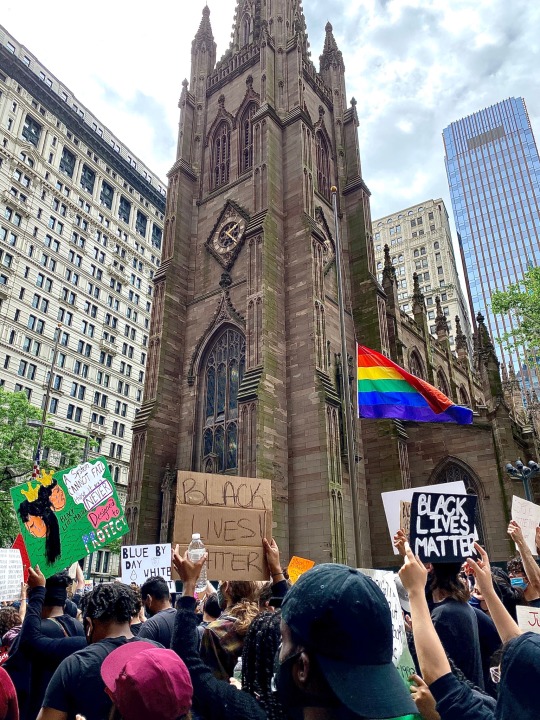
Peaceful Protest, New York, June 2nd
#Trinity church#new york#manhattan#foley square march#foley square protest#black live matter#george floyd#protest#peaceful protest#BLM#Pride#gay pride#upload
8 notes
·
View notes
